So the Shoshone game gave a good demonstration of early acceleration for science, coming in at turn 190. Of course, there's one other civ that plays huge in the early acceleration department: Spain. As I saw in the Sacred Sites games, Spain with the right natural wonder start might indeed be able to outrace everything else.
And there's one particular natural wonder that can accelerate an early start in directions other than religion more than any other: King Solomon's Mines. That's +6 hammers which Spain doubles to +12. That's obviously enormous, that's 9 marginal productivity over your typical 3-yield tiles early game, sort of equivalent to starting with your capital at size 10, better than even the Shoshone can do with population from ruins.
You'd think Lake Victoria (+6 food doubled to 12) would do the same thing, but I played two partial starts with that natural wonder and found that it really didn't. It takes longer than you think to convert that food into hammer production, and often isn't even possible at all thanks to lack of hills. Solomon accelerates more from turn one, putting out scouts and settlers far faster than anything else. Victoria might be competitive if Civ 5 had Civ 4's rule that all surplus food goes into settlers, but with the fractional conversion that Civ 5 does have, Solomon thoroughly outpaces Victoria on building settlers.
So I followed the same procedure as the Spain culture game, rolling maps until I found the desired natural wonder within a few steps of the start, then reloaded to move the starting settler directly there. After a thoroughly undisclosed amount of time, we got it.
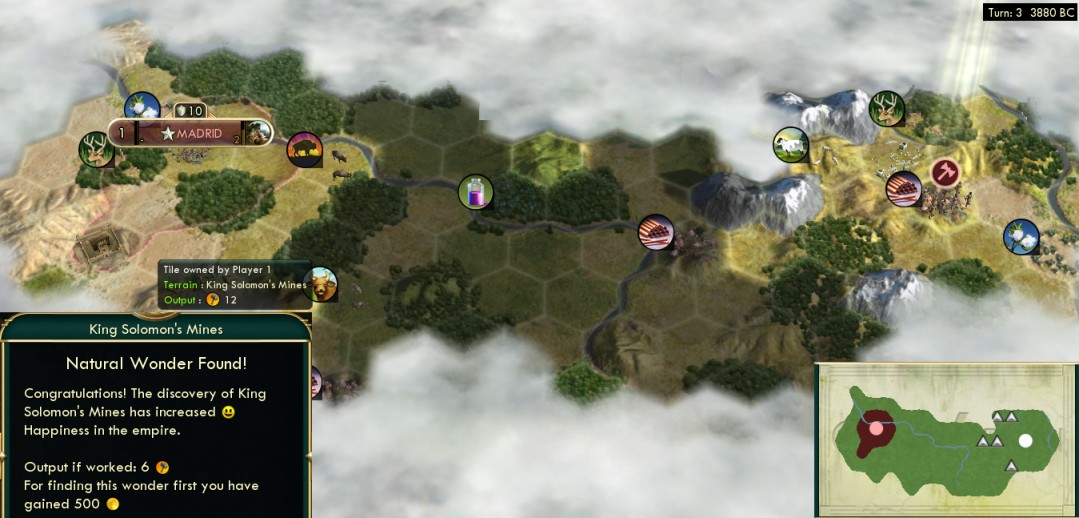
Unlike my previous Spain game, this game found only one natural wonder immediately, we couldn't count on having a second 500 gold to spend. I still think scouting is more important than an immediate settler, so bought two scouts right away (plus the Solomon tile itself.)
But also unlike any previous game, we have King Solomon's Mines producing 12 hammers per turn right away, obviously productivity unmatchable in any other way. Madrid could and did build one more scout in just two turns (finished on turn 5), followed by an archer (t8) then the worker (t12).
The three scouts plus the starting warrior explored the four grooves of the inland sea as usual, finding lots of ruins. I got Archery, culture well timed on turn 5, 90g, map, archer upgrade, Mining, t13 culture again, 65g, map, t16 culture AGAIN, Animal Husbandry, 95g.
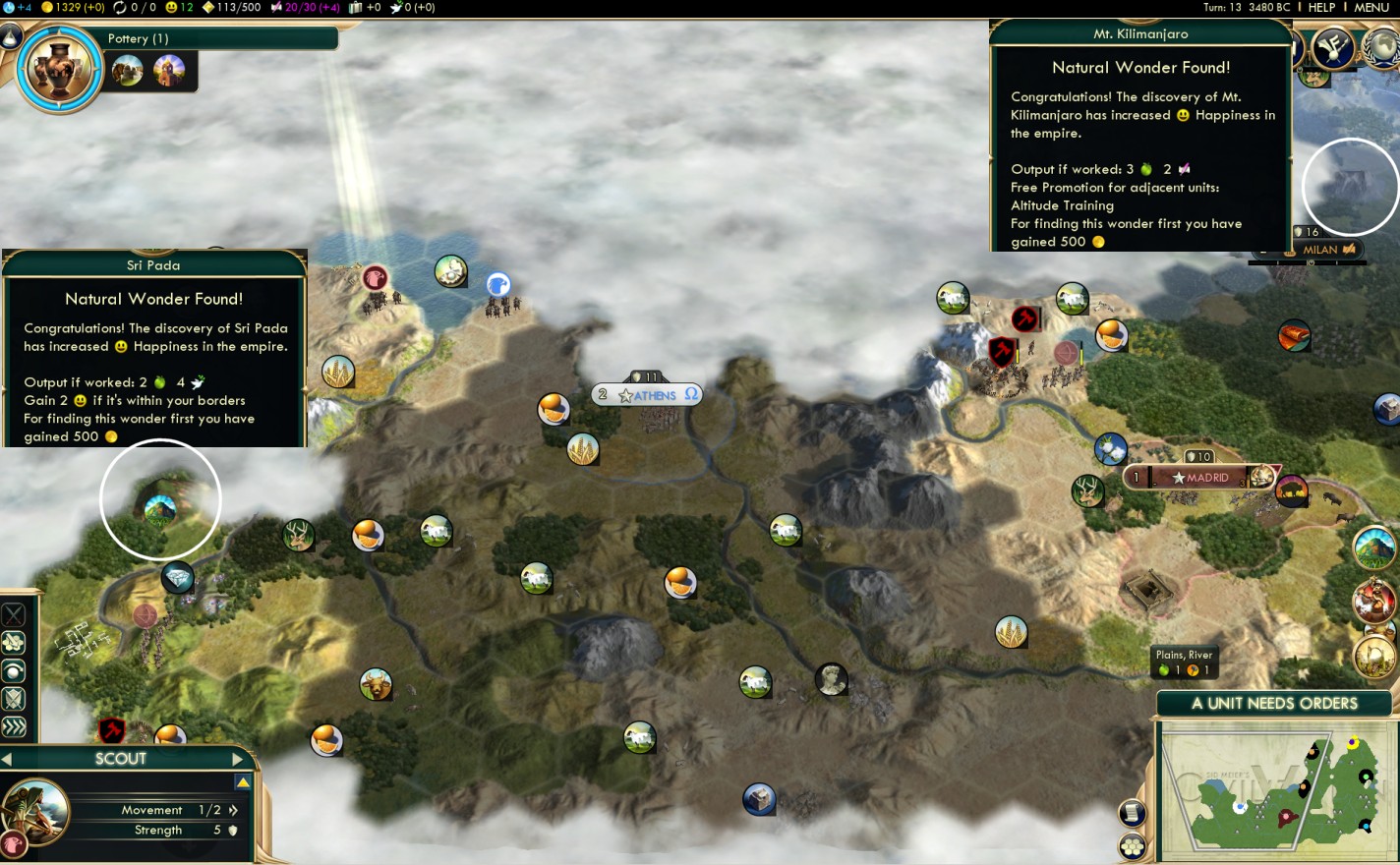
And, critically and awesomely, two more virgin natural wonders. 1300 gold in the treasury now to blow out.
Except for one crucial problem. Missing from that list of ruins rewards was population. Settlers can't be built or bought until the city is at size 2. The ideal Spain start involves a pop ruin to size 2 ASAP, but it didn't happen here. I didn't want to manually grow the city by working food, since that would mean coming off the massive Solomon tile. But all my fortune can't buy food.

The best workaround I could do was this. The moment Pottery was in, I bought the granary. That plus working the deer tile makes +5 food. That gets the 15 food for growth in just 3 turns, and actually only misses out on Solomon for 2, since on the 3rd turn the city will grow and auto-pick the hammer tile to use that same turn. So Madrid got to size 2 on turn 17 to start buying settlers.
I also bought the shrine right away, no time to lose on getting the pantheon up. The full list of early buys was this: t3 scout, t4 scout, t14 granary, t14 shrine, t17 settler, t25 settler, t26 settler, t32 worker, t32 archer.
Where did the money for those additional settlers and workers come from?
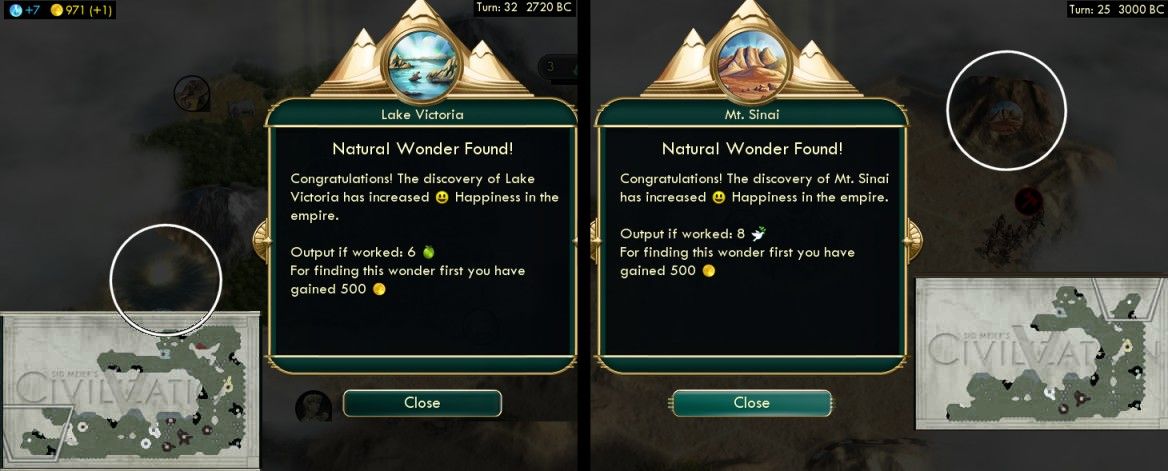
Two MORE virgin natural wonders, for a total of five! I got really lucky there. 5 of the 6 were within 90 degrees of me on the map, and these two were off in the corners so I could still find them first.
There were also more ruins: t22 finally got population (it went into the second city), t28 60 gold, t30 culture for a fourth time, t44 90 gold, t45 the big 60 faith, t51 a late Writing.
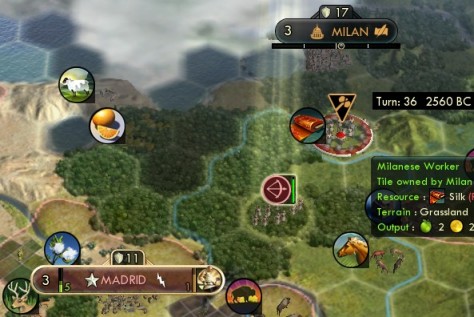
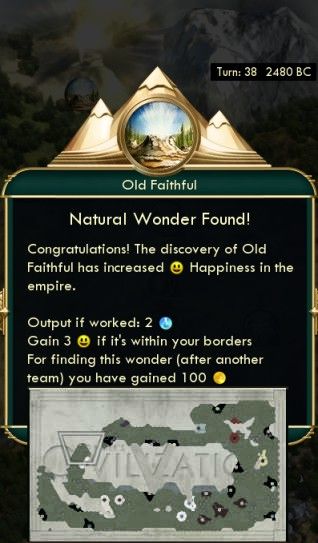 And the good old classic means of acceleration, steal a worker. Not super impactful with Madrid now rapidly building workers with Solomon, but still welcome.
And the good old classic means of acceleration, steal a worker. Not super impactful with Madrid now rapidly building workers with Solomon, but still welcome.
And the last natural wonder, boo it's only worth 100 gold what a ripoff, haha.
So on turn 39, let's compare this game to the Shoshone game. They just got their second city planted on this date. How is Spain doing?
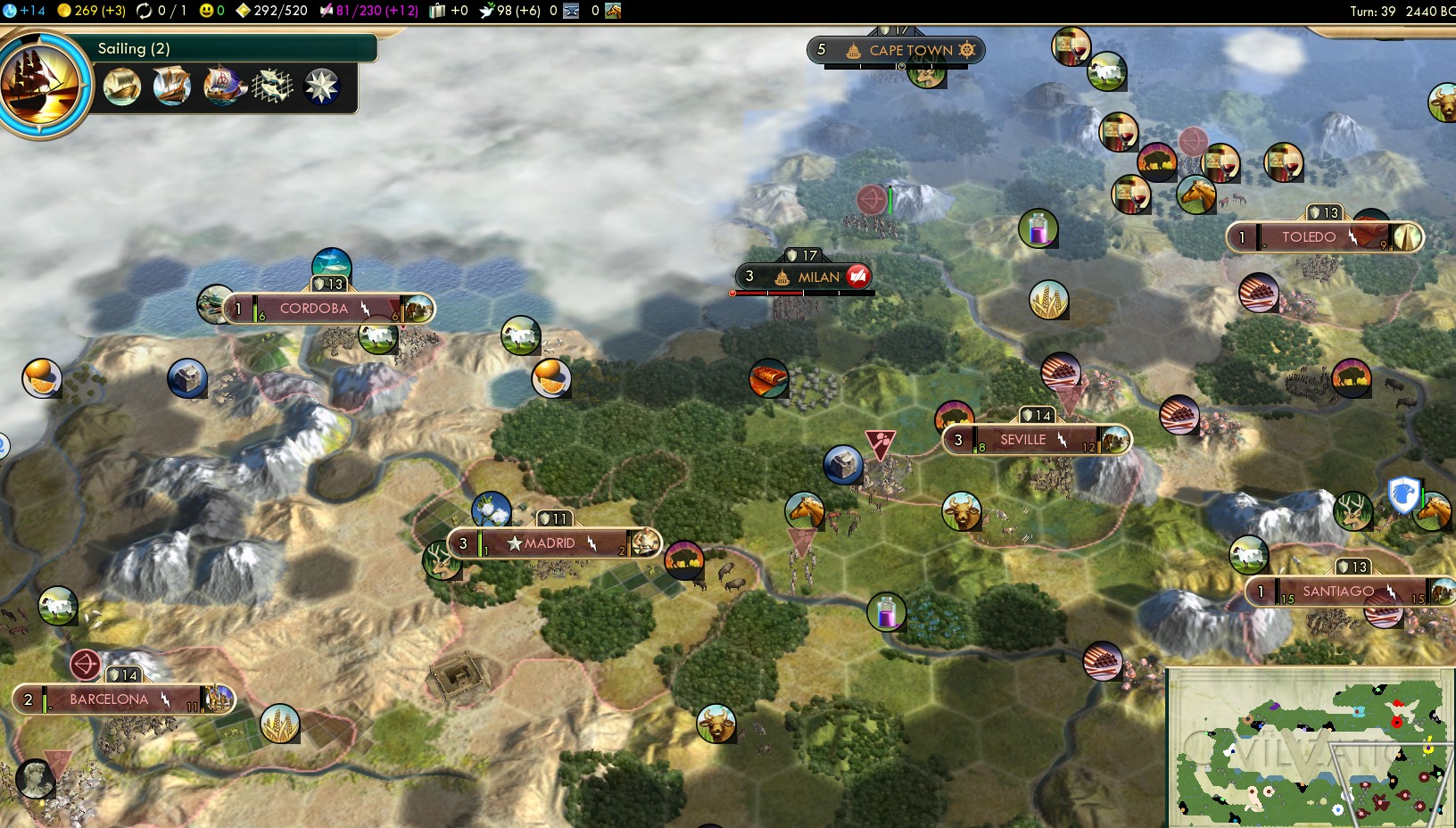
Spain has SIX. Four full cities ahead of the Shoshone. Also 11 turns ahead of the pace to six cities in my Spain culture game.
I'm also taking serious advantage of one overlooked detail of Spain's civ ability. Besides the gold and double yield, they also get double happy from natural wonders. I'd now found all six, and needed every single bit of that happy to stay at zero right here.
That happy crunch happened because somehow I managed to overlook hooking up any early luxuries. I have none connected yet in this picture, except for copper under just-founded Toledo. The cotton at Madrid got delayed for lack of worker labor, and we hadn't gotten to the techs for marble and crab yet. But now they're all getting attention to come online soon, we're about to buy the work boat for Cordoba's crab. Toledo is founded directly on copper because we had to have it right away.
Another minor problem: I settled my cities to grab lots of resources, but many of them were out in the third ring. I had to buy quite a few of these tiles. But that was OK, by now we had the basics of workers and settlers all bought, and there wasn't any other pressing immediate need to spend the gold on.
Tradition: Opener on t8 via ruin, Oligarchy t13 via ruin, Legalism t21 via ruin, Landed Elite t33 (wow that's fast! and the capital needed it badly), t51 Aristocracy (for Hanging Gardens), t73 finisher which is also quite fast indeed. This happened thanks to settling the cities very quickly to get the Legalism monuments running.
Research: The usual plan of most of the ancient techs, then Currency for Petra, then Engineering for the aqueducts before going to Philosophy then Education. Engineering also went through Construction and we did need lumbermills.
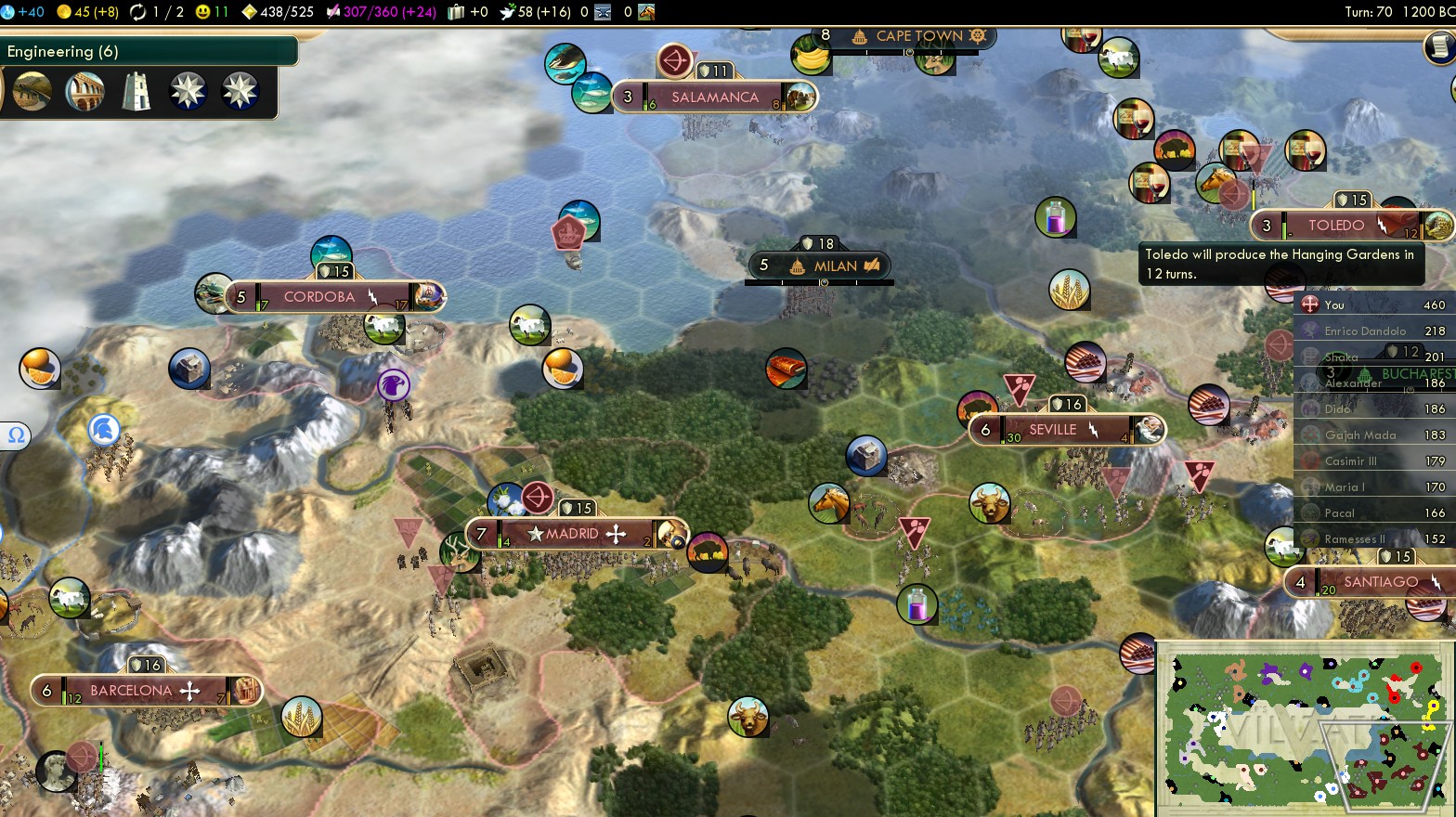
Another overview to compare with the Shoshone game. Ahead by 44 population to 21 which is quite a swing (although affected by deliberately holding the Shoshone cities to convert at size 1), and you can compare whatever other metrics you like.
I did add a 7th city, up there at Salamanca. I had happy headroom, and it seemed worthwhile with two luxuries (it's on citrus). And also your second coastal city is your most valuable one, because that unlocks the ability for the two of them to swap sea trade routes with each other. Cordoba had alertly built a cargo ship ahead of time to send to Salamanca right at its founding with boatloads (literally) of food, to get it caught up on growth. The ship Cordoba is building in this picture is the second one, which would send food in the reverse direction, Salamanca to Cordoba.
Toledo is making a bold bid for the Hanging Gardens. Because it's the most food poor of my cities and needs some power to get all those resources. I also gave it a caravan food route, and also took Aristocracy before Monarchy for this. There were only 2 civs in Tradition, so not much competition, and I did get the HG here. The free Garden also helps in this city that's off fresh water.
And Petra is going up in Barcelona, which has more desert hills to make use of it than the capital. Getting these cities founded so early had a nice effect that they matured early enough to pick and distribute their wonders, rather than having to pack them all into the capital. I then had enough city power to fill in some often-skipped wonders: Hagia, Chichen, Borobudur, Colossus.
One downside to so much city acceleration: they outpaced the religion and its pressure, so I wouldn't get to pull the convert-at-size-1 trick. So the religious game plan just came on a normal unaccelerated schedule. I got the religion on t49, then had to take two missionaries to get it spread to my cities, and didn't enhance until around t100. Still, this is a tiny loss. We'll still have enough faith. The critical amount of faith is all the pagodas by the end of the renaissance, which we'll still easily hit. Any faith beyond pagodas just goes into extra missionaries, which give rather marginal returns.
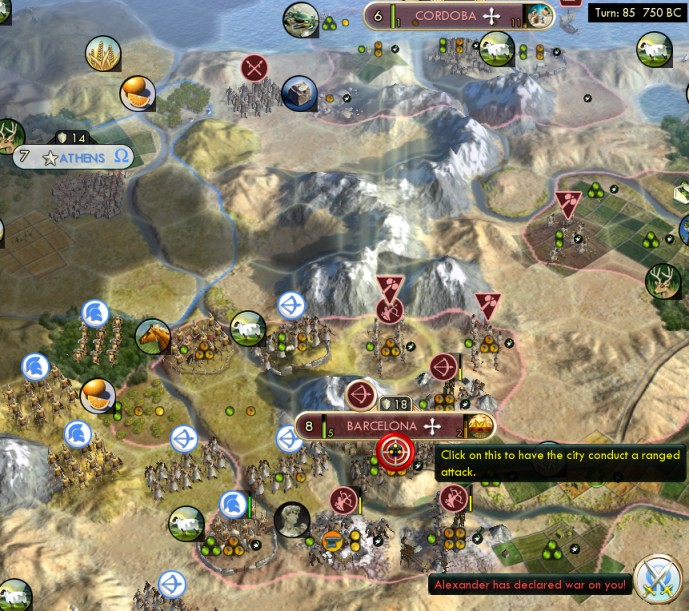
My neighbor Greece declared war! I'd seen this coming when he got mad at me for settling in his direction. (Oddly, both Barcelona and Cordoba are exactly equidistant from Athens and Madrid, but he got mad for only Barcelona. I don't know why.) Anyway, I knew he was attacking sometime. I didn't expect it quite so soon, but saw the units marching early enough to bring all of mine over here. It looks like a lot of Greek attackers, but there's no siege in there so it's no threat to the city. I did pay for two comp bow upgrades and built one more, which all held this off easily until we signed peace.
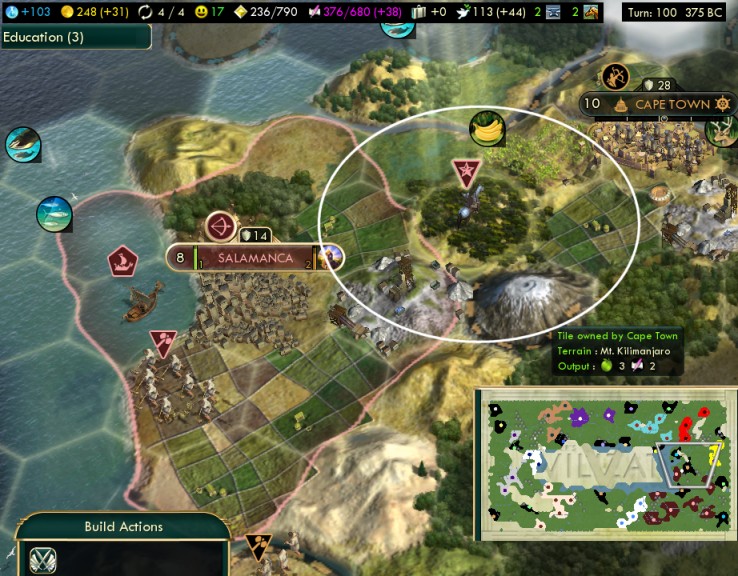
But I did keep the war going long enough to spawn a Great General, for this. I finally fulfilled Spain's birthright with another natural wonder to work, stealing Mt Kilimanjaro from Cape Town here. A banana plantation also came over in the deal.
Policies: Same as the Shoshone game, we would have the 7th and 8th regular plus Oracle policies to sink in the medieval era. And Mercantilism is still the best choice three-deep anywhere. The Commerce opener came on t90, Landsknechts on t97 via the Oracle, then Mercantilism on t107. I got decent use out of that, buying two universities in the low-hammer coastal cities.
t103 Education and start the universities. Same as Shoshone game, would have time to get through Compass to Astronomy for Renaissance entry to unlock Rationalism for the 10th policy.
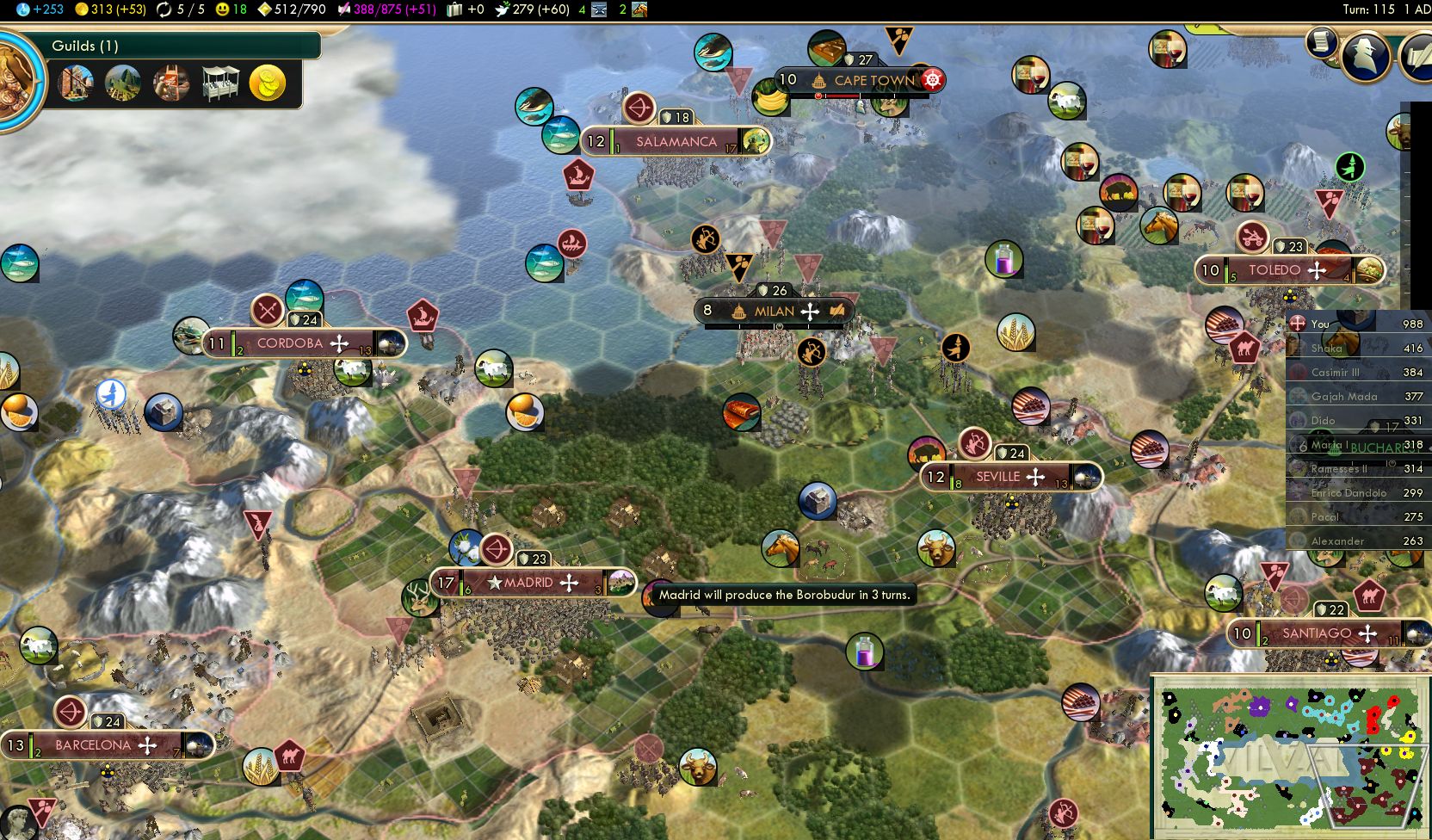
I'm throwing out a lot of screenshots to compare, but I'm really curious myself as to exactly where some of these game plans can get ahead of others. Spain is just about 7 turns ahead of where the Shoshone were here, on both research and constructing the universities. Spain is also ahead by 2-3 population per city, although less in total, 85 to 104, but of course that will happen with fewer cities on a not-huge map.
Nothing happened for a while. One unusual bit was that I got a second happiness Golden Age, that virtually never happens. Here it came about thanks to a whole bunch of mercantile city-states cascading resource quests into each other. I had 20 to 30 surplus happiness with no effort invested. This represents wasted potential that I could have supported more cities, but by now it was too late for them to mature into substantial science production in any helpful time frame.
t129 World Congress. Sciences Funding last time was a mistake to chase. It's just too slow. It would kick in on t160, and I need the scientists complete by about t175, so screw that. I picked the World's Fair instead, since that kicks in the free policy immediately as soon as the fair completes; ideally it would be the Rationalism finisher or Spaceflight Pioneers.
I followed the same renaissance-industrial plan as the Shoshone. Tech to Industrialization first and buy three factories to open the ideology. But Spain here got to take Skyscrapers right away since we didn't need to take the happy tenet first. I didn't need to faith-engineer-rush Big Ben, slowbuilding it was fine, and let me save a faith engineer to rush a spaceship part instead.
Policies: Rationalism interleaved with Order. Spain got through policies faster than the Shoshone did, thanks to more cultured city-states and smarter Great Writer usage. I saved three writers (including Globe Theater) until after 8 turns of stacking up a golden age, Sistine Chapel, and the industrial era value for cultured CS.
The full schedule: t124 Rationalism opener, t137 Secularism, t146 Workers' Faculties, t148 Humanism via writer bulb, t157 Free Thought, t163 both Socialist Realism and Party Leadership by way of 3 writer bulbs (timed to max their culture yield after 8 turns of Sistine + Golden Age + industrial era cultured CS value), t171 Sovereignty, t177 Rationalism finisher via World's Fair, t182 Spaceflight Pioneers thanks to the World's Fair culture bonus.
Moving ahead quickly (because the game did), here's the next overview. Who's ahead, Spain or Shoshone?
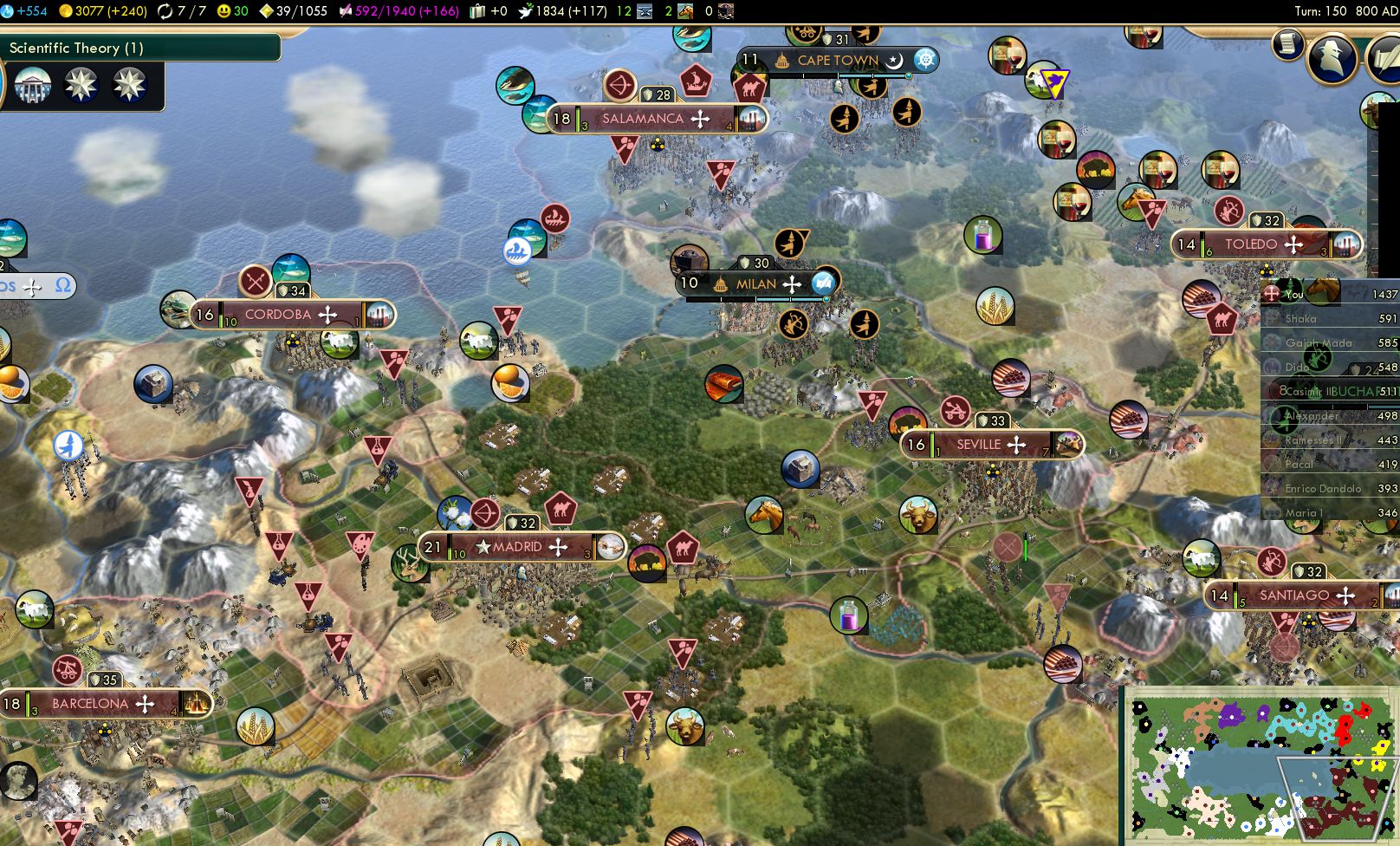
Holy crap, we're exactly tied! One turn away from Sci Theory here for both civs.
What happened? Spain had been like 8 turns ahead back at universities. How did we lose that lead? Well, I can't say why I'm surprised by this: having 50% more cities produces 50% more beakers. Who knew. Spain did still have some advantages, though:
1. Spain has the money and Skyscrapers to buy Public Schools right away, rather than slowbuilding them. That would speed up both beakers and great scientists a bit and maybe reclaim some of the lost ground.
2. Spain is about 1.5 social policies ahead. That also speeds up beakers (Spain has Workers' Faculties earlier), but most importantly would reach Spaceflight Pioneers, which was something the Shoshone didn't manage.
3. Spain is ahead by about one great scientist: the last-to-spawn city is ahead by about 50 scientist GPP now thanks to the earlier universities, plus Spain's buying the public schools 10 turns ahead of the Shoshone building them.
Anyway, we built the public schools. I always talk about how the second half of the game after universities tends to be incompressible, but I tried anyway. Right as the public schools completed, I shut down food production in most cities (except the Petra one) in order to switch to maximum Secularism specialists. I'm pretty sure this is correct. A rough calculation: a size 18 city needs 132 food to grow after aqueduct, about 100 base after Tradition and WLKTD. To pay that back requires the new citizen spending 50 turns working a 4-food tile. There weren't 50 turns left, of course.
I was determined not to overshoot the end of the tech tree this time, and had at least one more Great Scientist coming than the Shoshone thanks to Spaceflight Pioneers. So I spent two bulbs to Plastics this time, reaching that on t164. Then it's correct to wait 8 turns for the sliding window of beaker history to fill up with research labs, then spend all the bulbs freely from there. (The Shoshone had bulbed towards Rocketry before that 8 turn window filled; Spain had more room between an earlier Plastics and fewer beakers going slower towards Rocketry, so didn't need to spend any bulbs before getting full value from the labs.)
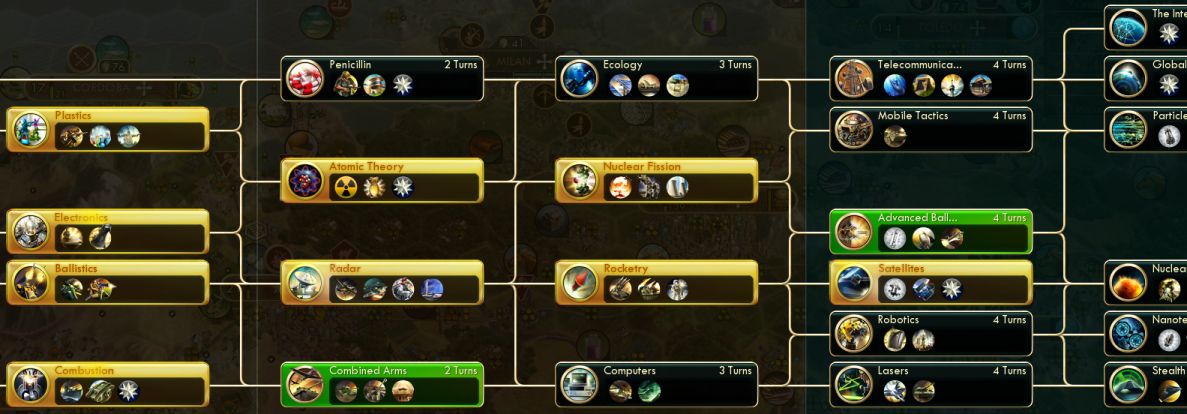
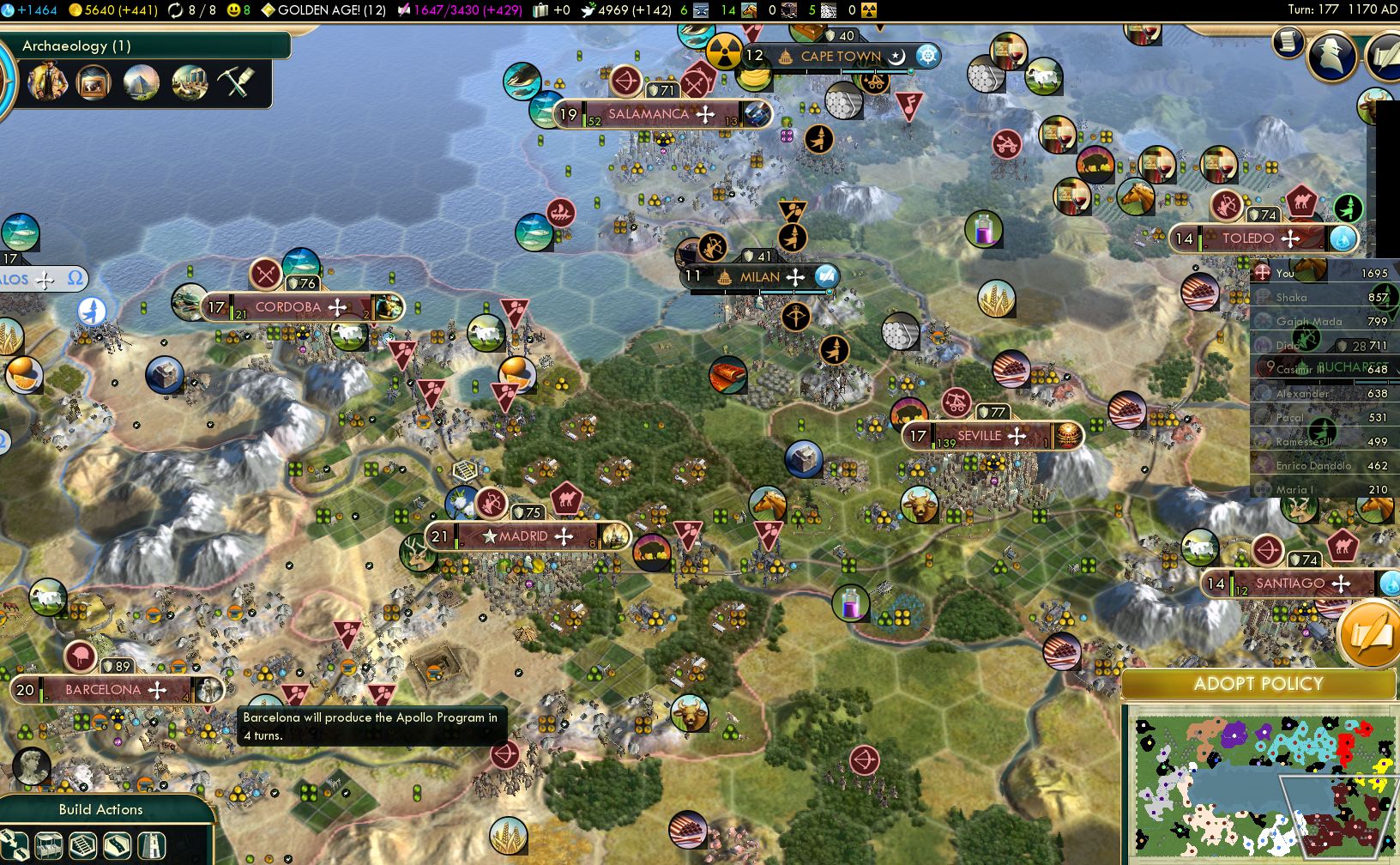
Here's a look at how things get set up in the endgame. Beaker production is maxed out just under 1500; there would be no more population growth or science buildings to add, so all the bulbs can be spent now for maximum value. So I bulbed all the scientists I had so far, getting up to Satellites. Apollo is close to completion in Barcelona. Madrid is doing the Kremlin, for Spaceflight Pioneers. The world just completed the World's Fair, which I would use right now for the Rationalism finisher to claim Advanced Ballistics. (It's optimal to push this all the way to a final-column most-expensive tech, but usually hard to time precisely for that, so a penultimate column tech is good enough.) Hubble is underway at Salamanca, and would get rushed with a faith engineer.
I continued to acquire more scientists: two by faith, two by Hubble, one by Porcelain Tower, one by Spaceflight Pioneers. They all bulbed neatly up to the end of the tech tree, perfectly finishing the last tech just as all the rest of the SS parts completed. And there was enough faith in the bank to also buy two engineers, so of the three, one could rush Hubble and two could go for SS parts. That was right to do for this civilization: I had four good spaceship building cities (Madrid, Barcelona, Cordoba, Salamanca), but all three eastern cities were pretty weak, small in size and no hydro plant. So I needed to rush two parts with engineers.
 I had to work around an emergency when I forgot that Great Engineers don't fully complete a SS part. They only yield 300 + 30*pop hammers, 900 in a size 20 city, but the part costs 1500. But I made up for this losing no turns. I was able to start and rush the second-to-last part in Seville early enough for it to complete with the rest. Then Barcelona completed its SS Cockpit with enough time left to set up an overflow chain of two items (one being the cockpit itself), so the engineer plus two turns of overflow managed to complete the last part in a single turn.
I had to work around an emergency when I forgot that Great Engineers don't fully complete a SS part. They only yield 300 + 30*pop hammers, 900 in a size 20 city, but the part costs 1500. But I made up for this losing no turns. I was able to start and rush the second-to-last part in Seville early enough for it to complete with the rest. Then Barcelona completed its SS Cockpit with enough time left to set up an overflow chain of two items (one being the cockpit itself), so the engineer plus two turns of overflow managed to complete the last part in a single turn.
So who won, Shoshone or Spain?

Spain brought it home on turn 191 1310 AD. Just ONE TURN SLOWER than the Shoshone, haha. (Although marginally faster when you consider Spain's initial settler started on turn 3 after walking to King Solomon's Mines.)
Although really the difference between these games was the Shoshone playing on a huge map with more cities and beaker production. I'm becoming increasingly convinced that wider is better for science. Not crazy-ICS every-possible-city wide, but 10-12 cities just always seem to outpace 4-7, even with the tech cost penalty. So yes, I will have to continue trying things along those lines.